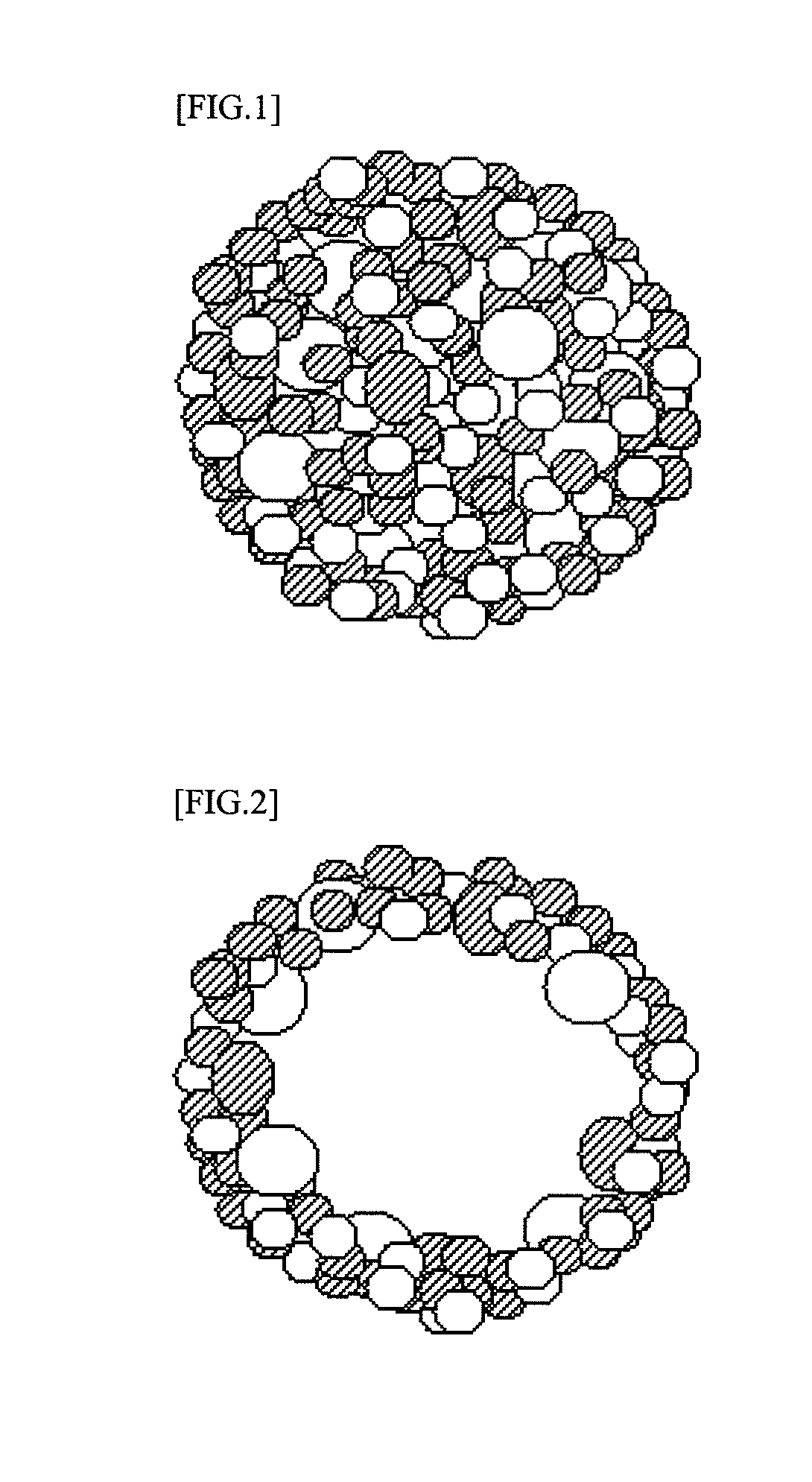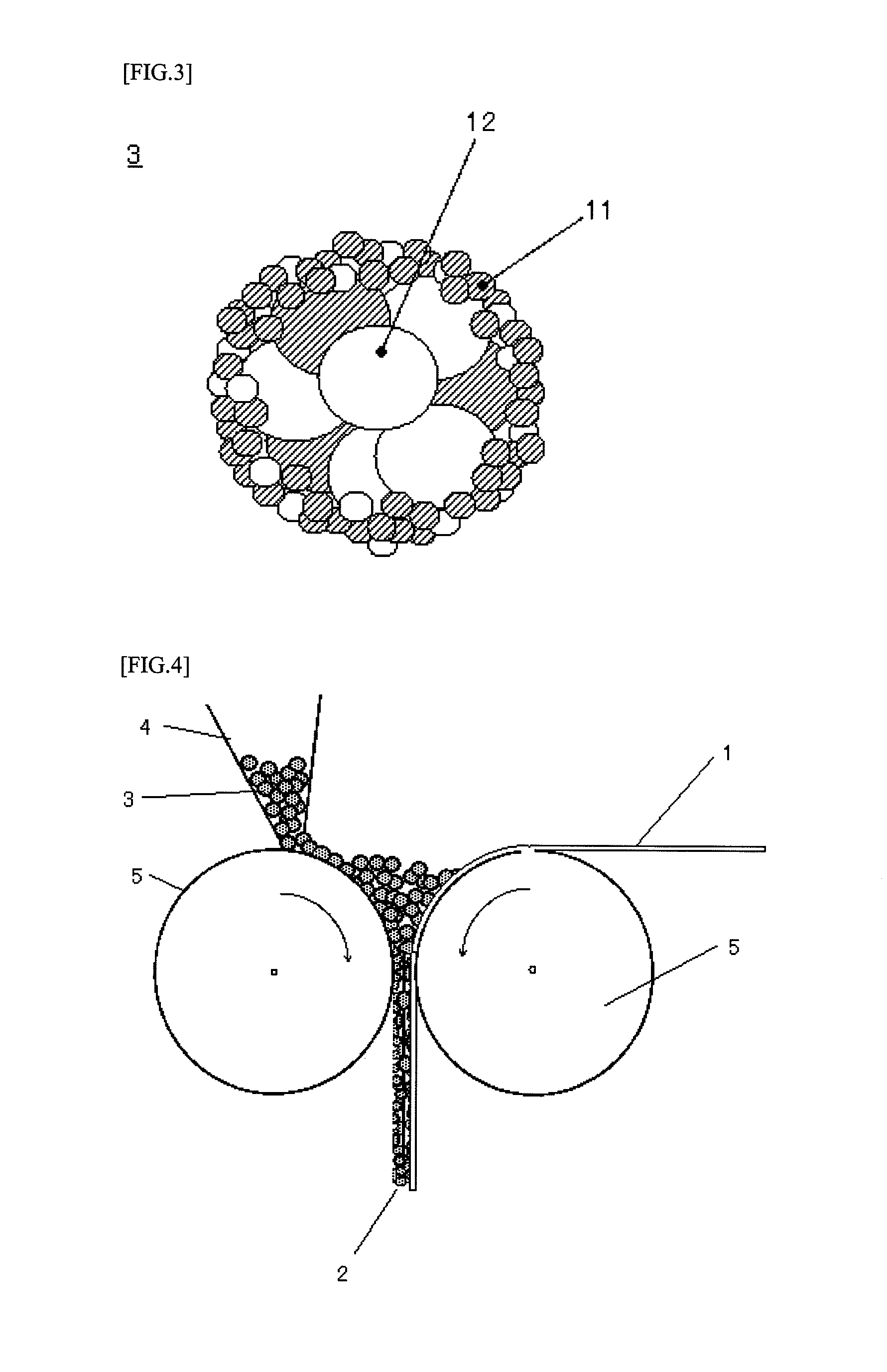Composite particles for electrochemical element electrode
a technology of electrochemical element electrodes and composite particles, which is applied in the direction of non-metal conductors, cell components, conductors, etc., can solve the problems of difficult to obtain electrode sheets stably and continuously, particle formability inferiority, etc., and achieve large electric capacitance and low internal resistance
- Summary
- Abstract
- Description
- Claims
- Application Information
AI Technical Summary
Benefits of technology
Problems solved by technology
Method used
Image
Examples
example 1
[0084]100 parts of electrode active material (activated carbon having specific surface area of 2000 m2 / g and weight average particle diameter of 5 μm), 5 parts of electric conductive material (acetylene black “Denka Black Powder”: manufactured by Denki Kagaku Kogyo K.K.), 7.5 parts of dispersible binder (aqueous dispersion of cross-linked acrylate polymer with average particle diameter of 0.15 μm, and glass transition temperature of −40° C.: “AD211”: manufactured by Zeon Corporation), 93.3 parts of soluble resin (1.5% aqueous solution of carboxymethyl cellulose “DN-800H”: manufactured by Daicel Chemical Industries, Ltd.), and 341.3 parts of ion exchanged water were stirred and mixed by a TK homomixer to obtain slurry having solid content of 20%. Subsequently, the slurry was charged into a hopper 51 of a spray drier (with a pin type atomizer, manufactured by Ohkawara Kakohki Co. Ltd.) as shown in FIG. 5, and sent to the top nozzle 57 with pump 52, and sprayed from the nozzle into the...
example 2
[0086]Slurry was obtained in the same manner as in the Example 1 except that 5.6 parts of polytetrafluoroethylene were used in the place of the binder (AD-211) used in the Example 1, and by use of this slurry, a spherical composite particle A-2 of particle diameter 5 μm to 70 μm (average particle diameter of 50 μm) was obtained. The composite particle A-2 consisted of a core portion and an outer shell portion in the same manner as the composite particle A-1, and the weight average particle diameter of the electrode active material and the electric conductive material which form the outer shell portion, was smaller than the weight average particle diameter of the electrode active material and the electric conductive material which form the core portion, and had the same structure as that of the particles as shown in FIG. 3.
[0087]The obtained composite particle was rolled and formed by use of the roll pressing machine in the same manner in the Example 1, and an electrode sheet having ...
example 3
[0088]Slurry S1 (solid content 8%) made of 2 parts of an electric conductive material (Denka Black Powder: manufactured by Denki Kagaku Kogyo), 7.5 parts (solid content 40%) of a binder (AD211: manufactured by Zeon Corporation), 3.33 parts (solid content 4%) of carboxymethyl cellulose (“DN-10L” manufactured by Daicel Chemical Industries, Ltd.), 17.76 parts (solid content 1.5%) of carboxymethyl cellulose (“DN-800H” manufactured by Daicel Chemical Industries, Ltd.), and 36.9 parts of ion exchanged water was prepared.
[0089]100 parts of an electrode active material (activated carbon having specific surface area of 2000 m2 / g and weight average particle diameter of 5 μm) was charged into an Agglomaster manufactured by Hosokawa Micron Corp., and it was fluidized by 80° C. hot wind, and the above slurry S1 was atomized into the Agglomaster, and fluidized-granulation was performed to give a particle A. The average particle diameter of the particle A was 40 μm.
[0090]Slurry S2 (solid content 1...
PUM
| Property | Measurement | Unit |
|---|---|---|
| broad particle diameter distribution | aaaaa | aaaaa |
| average particle diameter | aaaaa | aaaaa |
| average particle diameter | aaaaa | aaaaa |
Abstract
Description
Claims
Application Information
 Login to View More
Login to View More - R&D
- Intellectual Property
- Life Sciences
- Materials
- Tech Scout
- Unparalleled Data Quality
- Higher Quality Content
- 60% Fewer Hallucinations
Browse by: Latest US Patents, China's latest patents, Technical Efficacy Thesaurus, Application Domain, Technology Topic, Popular Technical Reports.
© 2025 PatSnap. All rights reserved.Legal|Privacy policy|Modern Slavery Act Transparency Statement|Sitemap|About US| Contact US: help@patsnap.com



